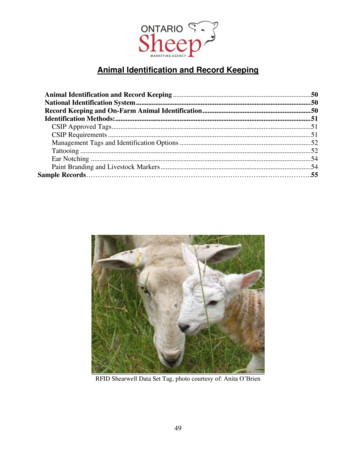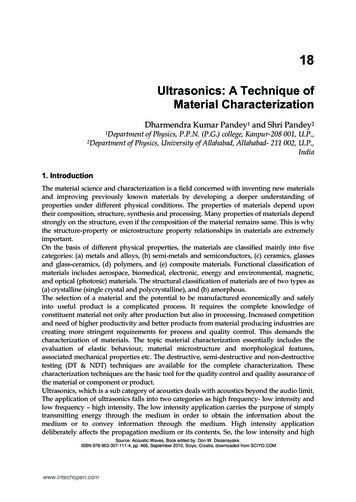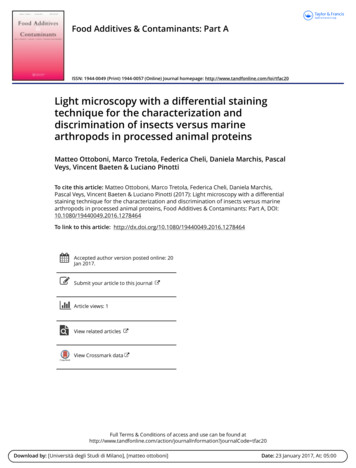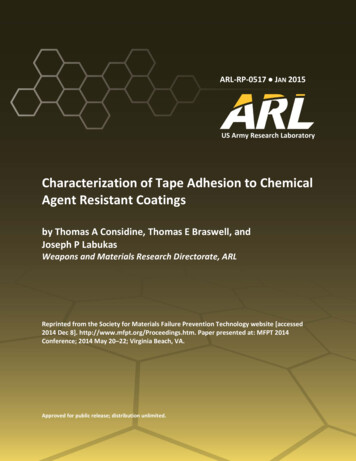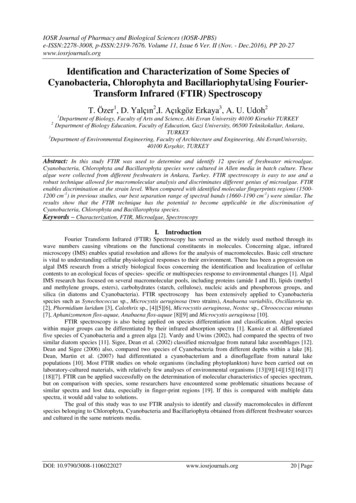
Transcription
IOSR Journal of Pharmacy and Biological Sciences (IOSR-JPBS)e-ISSN:2278-3008, p-ISSN:2319-7676. Volume 11, Issue 6 Ver. II (Nov. - Dec.2016), PP 20-27www.iosrjournals.orgIdentification and Characterization of Some Species ofCyanobacteria, Chlorophyta and BacillariophytaUsing FourierTransform Infrared (FTIR) SpectroscopyT. Özer1, D. Yalçın2,I. Açıkgöz Erkaya3, A. U. Udoh21Department of Biology, Faculty of Arts and Science, Ahi Evran University 40100 Kirsehir TURKEYDepartment of Biology Education, Faculty of Education, Gazi University, 06500 Teknikokullar, Ankara,TURKEY3Department of Environmental Engineering, Faculty of Architecture and Engineering, Ahi EvranUniversity,40100 Kırşehir, TURKEY2Abstract: In this study FTIR was used to determine and identify 12 species of freshwater microalgae.Cyanobacteria, Chlorophyta and Bacillarophyta species were cultured in Allen media in batch culture. Thesealgae were collected from different freshwaters in Ankara, Turkey. FTIR spectroscopy is easy to use and arobust technique allowed for macromolecular analysis and discriminates different genius of microalgae. FTIRenables discrimination at the strain level. When compared with identified molecular fingerprints regions (15001200 cm-1) in previous studies, our best separation range of spectral bands (1660-1190 cm-1) were similar. Theresults show that the FTIR technique has the potential to become applicable in the discrimination ofCyanobacteria, Chlorophyta and Bacillarophyta species.Keywords – Characterization, FTIR, Microalgae, SpectroscopyI. IntroductionFourier Transform Infrared (FTIR) Spectroscopy has served as the widely used method through itswave numbers causing vibrations on the functional constituents in molecules. Concerning algae, infraredmicroscopy (IMS) enables spatial resolution and allows for the analysis of macromolecules. Basic cell structureis vital to understanding cellular physiological responses to their environment. There has been a progression onalgal IMS research from a strictly biological focus concerning the identification and localization of cellularcontents to an ecological focus of species- specific or multispecies response to environmental changes [1]. AlgalIMS research has focused on several macromolecular pools, including proteins (amide I and II), lipids (methyland methylene groups, esters), carbohydrates (starch, cellulose), nucleic acids and phosphorous groups, andsilica (in diatoms and Cyanobacteria). FTIR spectroscopy has been extensively applied to Cyanobacteriaspecies such as Synechococcus sp., Microcystis aeruginosa (two strains), Anabaena variabilis, Oscillatoria sp.[2], Phormidium luridum [3], Calothrix sp., [4][5][6], Microcystis aeruginosa, Nostoc sp., Chroococcus minutus[7], Aphanizomenon flos-aquae, Anabaena flos-aquae [8][9] and Microcystis aeruginosa [10].FTIR spectroscopy is also being applied on species differentiation and classification. Algal specieswithin major groups can be differentiated by their infrared absorption spectra [1]. Kansiz et al. differentiatedfive species of Cyanobacteria and a green alga [2]. Vardy and Uwins (2002), had compared the spectra of twosimilar diatom species [11]. Sigee, Dean et al. (2002) classified microalgae from natural lake assemblages [12].Dean and Sigee (2006) also, compared two species of Cyanobacteria from different depths within a lake [8].Dean, Martin et al. (2007) had differentiated a cyanobacterium and a dinoflagellate from natural lakepopulations [10]. Most FTIR studies on whole organisms (including phytoplankton) have been carried out onlaboratory-cultured materials, with relatively few analyses of environmental organisms [13][9][14][15][16][17][18][7]. FTIR can be applied successfully on the determination of molecular characteristics of species spectrum,but on comparison with species, some researchers have encountered some problematic situations because ofsimilar spectra and lost data, especially in finger-print regions [19]. If this is compared with multiple dataspectra, it would add value to solutions.The goal of this study was to use FTIR analysis to identify and classify macromolecules in differentspecies belonging to Chlorophyta, Cyanobacteria and Bacillariophyta obtained from different freshwater sourcesand cultured in the same nutrients media.DOI: 10.9790/3008-1106022027www.iosrjournals.org20 Page
Identification and Characterization of Some Species of Cyanobacteria, Chlorophyta and .II. Methodology1.Collection and processing of samplesSamples were collected from natural freshwaters in Ankara (Turkey), and Arthrospira platensisGomont (Syn: Spirulina platensis (Gomont) Geitler), Dolichospermum affine (Lemmermann) Wacklin,L.Hoffmann & Komárek (Syn: Anabaena affinis Lemmermann), Geitlerinema lemmermannii (Woloszynska)Anagnostidis (Syn: Oscillatoria lemmermannii Woloszynska), Microcoleus autumnalis (Gomont) Strunecky,Komárek & J.R.Johansen (Syn: Phormidium autumnale Gomont), Oscillatoria princeps Vaucher ex Gomont,Oscillatoria sp., Pseudanabaena mucicola (Naumann & Huber-Pestalozzi) Schwabe (Syn: Phormidiummucicola Nauman & Huber-Pestalozzi), Spirogyra sp., Stigeoclonium nanum (Dillwyn) Kützing, Stichococcussubtilis (Kützing) Klercker, Achnanthes sp., Nitzschia palea (Kützing) W.Smith and strains isolated from them.Micromanipulation technique was used to isolate the microalgae [20] stored and maintained in 250 mLErlenmeyer flasks containing 100 mL of Allen medium. The pH of the medium was adjusted to 6.8 with 1NNaOH [21]. All cultures were illuminated at 20 - 25 C in a 18 h-light/6 h-dark cycle with a photon flux densityof 50 µmol photons m-2 s-1 under fluorescent tubes. The mean biovolume for individual algal cells wascalculated from the geometrical formula according to Standard Operation for Phytoplankton Analysis (2007).For the measurement, fresh weight and determination of Chlorophyll a, samples were filtered through WhatmanGF/C glass fiber filters. The pigments were extracted in 90% methanol. Extract absorbance was measured at 665and 750 nm [22]. Quantitative features of the species in culture medium are given on Table 1. For spectralanalysis, (and all measurements) samples were prepared during their exponential phases and from this, 0.5 mLaliquots were resuspended in deionized water and droplets of the culture suspension spread out all over ‘Low-e’reflectance slides (Kevley Technologies) for monolayer preparations. Samples were then subsequently air-driedin a laminar flow at room temperature and stored in a desiccators pending analysis.2.Infrared AnalysisAnalysis of the batch cultures was performed by means of FTIR spectroscopy. Infrared analysis wascarried out at the nanotechnology laboratory of Bilkent University, Ankara (Turkey), using a Vertex 70Hyperion Scanning microscope fitted with a Bruker Tensor Model 37 FTIR spectrophotometer. Spectralresolution of mercury cadmium telluride (MCT) detector was 4 cm-1, with 128 co-added scans. Spectra werecollected using a 20x20 µm square aperture over the wave-number range 4000- 650 cm-1. Infrared absorptionspectra were then collected from a clear field (background) from algal colonies (Fig. 1), and a ratio was obtainedof the sample-to-background spectrum. The specimens were examined and analyzed in the dry state, without amounting medium or cover slip samples of the species studied, were initially examined by bright-fieldmicroscopy, and 33 individual colonies (one spectrum per colony). Spectral absorption bands were identified inrelation to published information. Supporting information on band assignments was also obtained by analysis ofrange of pure biochemical standards (protein, nucleic acid, fatty acid and soluble carbohydrate) as detailed in[12].3. Spectral AnalysisThe manipulation of spectra was carried out using Bruker OPUS 6.5 software. The spectra were base-linecorrected, using automatic baseline correction algorithm and normalized to amide I.III. ResultsUnder light microscope, from living cells, air-dried preparations of specimens showed typical image ofArthrospira platensis , Dolichospermum affine, Geitlerinema lemmermannii , Microcoleus autumnalisOscillatoria princeps Oscillatoria sp., Pseudanabaena mucicola, Spirogyra sp., Stichococcus subtilis,Stigeoclonium nanum, Achnanthes sp., and Nitzschia palea (Figure 1A-H). Spectral analysis was carried outover 25x25 µm areas of specimens in the same figures, generating infrared absorption spectra that were closelysimilar to each containing 11 clear bands over the wave-number range 4000-900 cm-1. Table 2 shows theassignments of the bands based on literature sources.Table 1. Quantitative features of the species in culture mediumCulturesArthrospira platensisDolichospermum affineGeitlerinema lemmermanniiMicrocoleus autumnalisOscillatoria princepsOscillatoria sp.Pseudanabaena mucicolaDOI: 10.9790/3008-1106022027Number of 7www.iosrjournals.orgweightChlorophyll a(µg L-1)2.673.088.623.185.206.674.2121 Page
Identification and Characterization of Some Species of Cyanobacteria, Chlorophyta and .Spirogyra sp.Stichococcus subtilisStigeoclonium nanumAchnanthes sp.Nitzschia palea0.380.20.231.340.121.120.35x1050.28 x1057.561.774.350.380.42Total biovolume of flamentous species and number of species of the others are given.Table 2. Tentative assignment of bands found in FTIR spectra of air-dried preparation of divisionsBandnumber1Band wavenumber(cm-1)Cyanobacteria nge ive assignment of bands to majormacromoleculesWATERv(O-H) stretchingPROTEINv(N-H) stretching (amide A)LIPID - CARBOHYDRATEMainly vas(CH2) and vs(CH2) stretchingCELLULOSE – FATTY ACIDSv(C O) stretching of estersPROTEIN amide I bandMainly v(C O) stretchingPROTEIN amide II bandMainly δ(N-H) bending and v(C-N)stretchingPROTEIN δas(CH2) and δas(CH3) bendingof methylLIPIDδas(CH2) bending of methylPROTEIN δs(CH2) and δs(CH3) bendingof methylCARBOXYLIC ACIDvs(C-O) of COOgroups of carboxylatesNUCLEIC ACID (and other phosphatecontainingcompounds)vas( P O)stretching of esCARBOHYDRATEv(C-O-C)ofpolysaccharidesNUCLEIC ACID (and other phosphatecontaining compounds) vs( P O) stretchingof esBand assignment based on ure 1A (a). Light microscope image of living cells from Geitlerinema lemmermannii culture. (b). The regionof analysis of air-dried sample position taken with light microscope attached to FTIR microscope.(a)(b)Figure 1B (a). Light microscope image of living cells from Microcoleus autumnalis culture. (b). The region ofanalysis of air-dried sample position taken with light microscope attached to FTIR microscope.DOI: 10.9790/3008-1106022027www.iosrjournals.org22 Page
Identification and Characterization of Some Species of Cyanobacteria, Chlorophyta and .(a)Figure 1C (a). Light microscope image of living cells from Oscillatoria princeps culture.(a)Figure 1D (a). Light microscope image of living cells from Pseudanabaena mucicola culture.(a)(b)Figure 1E (a). Light microscope image of living cells from Stichococcus subtilis culture. (b). The region ofanalysis of air-dried sample position taken with light microscope attached to FTIR microscope.(a)(b)Figure 1F (a). Light microscope image of living cells from Stigeoclonium nanum culture. (b). The region ofanalysis of air-dried sample position taken with light microscope attached to FTIR microscope.(a)(b)Figure 1G (a). Light microscope image of living cells from Achnanthes sp. culture. (b). The region of analysisof air-dried sample position taken with light microscope attached to FTIR microscope.(a)(b)Figure 1H (a). Light microscope image of living cells from Nitzschia palea culture. (b). The region of analysisof air-dried sample position taken with light microscope attached to FTIR microscope.DOI: 10.9790/3008-1106022027www.iosrjournals.org23 Page
Identification and Characterization of Some Species of Cyanobacteria, Chlorophyta and .M. autumnaleP. mucicolaOscillatoria sp.Spirogyra spO. princepsS. subtilisS. nanumAchnanthes sp.N. paleaFigure 2. Infrared absorption spectra from air dried colony of studied speciesCyanobacteriaChlorophytaFigure 3. Average Spectra of the 3 DivisionsBacillariophytaFigure 4. Differences between 3 divisionDOI: 10.9790/3008-1106022027www.iosrjournals.org24 Page
Identification and Characterization of Some Species of Cyanobacteria, Chlorophyta and .IV. DiscussionMany of the infrared spectral features have been previously used in relation to purified biochemicals,including the four major groups of biological macromolecules- nucleic acids [29], proteins [25], lipids [30] andpolysaccharides [31]. In recent years, it is also, being applied to more complex biological samples and wholeorganisms such as bacteria [26][4][17][32], fungi [33][34], higher plants [35], tissue culture cells [36],macroalgae [37][38][39] and microalgae [12][40][8][14][41][42][13]. Algal IMS research has focused onseveral macromolecular pools, including proteins (amide I and II), lipids (methyl and methylene groups, esters),carbohydrates (starch, cellulose), nucleic acids and phosphoryl groups, and silicate (in diatoms andcyanobacteria). Green algae, diatoms, and cyanobacteria have distinct chemical composition that can beobserved in the infrared absorption spectra [1]. FTIR spectra of phytoplankton cells in the range of4000-700 cm-1 are characterized by specific absorption bands of the major macromolecular compounds [42].Typically, green algae have a relatively high starch and cellulose content (cell walls and energy storage product)form 1100 to 900 cm-1 [9][1], diatoms have a distinctive silicate absorption at 1100-1600 cm-1 and 800 cm-1due to silica frustule (cell wall) [24][11], and cyanobacteria spectra are dominated by protein and lipid with lessabundant carbohydrates relative to green algae [5][4]. However, the proportions of these macromolecular poolscan vary substantially among species within these groups and with nutrient availability [24][3][7].All FTIR spectra showed a closely similar sequence of 11 distinct bands and were assigned a range ofvibrationally, active chemical groups, including residual water (–OH), lipid (–CH2), cellulose (–C O), protein(amide), nucleic acid ( P O) and starch (–C–O). Average spectra were obtained for all species in this study.The differences among the divisions of band positions in the fingerprints were observed. Particularly obvious,were the differences among the band intensities. FTIR microspectroscopy of phytoplankton results in complexabsorption spectra, analysis of which provide information on, qualitative (molecular ratios, populationvariability, species differentiation) information in freshwater systems [8]. FTIR spectra with clear bands wereobtained from A. platensis, D. affine, G. lemmermannii, M. autumnalis, O. princeps, Oscillatoria sp., P.mucicola, S. sp., S. subtilis, S. nanum, Achnanthes sp., and N. palea species (Fig.2). The molecular assignmentsof bands given on Table 2 are based on published data on phytoplankton, cyanobacterial, noncyanobacterial andhuman cells. The positions of individual bands are derived from several molecular sources.This study was consistent among bands 9, 10 and 11, with their joint derivations from carbohydrate inall the three divisions. In Cyanobacteria, Chlorophyta and Bacillariophyta, while the average positions of band 9were at 1160 cm-1, 1152 cm-1and 1152 cm-1 respectively, band 11 was at 1034 cm-1, 1043cm-1 and 1053 cm-1respectively, with the position of band 10 being detected at 1090 cm-1only in Cyanobacteria (Table 2). Thegrouping of bands 9-11 is due to their joint derivation from υ(C–O–C) stretching of polysaccharides. The bandposition at 1080 cm-1 was attributed to the υ(P O) stretching of nucleic acid [27][4][26]. In these algae, bands6 and 7 suggested that they were dominated by the δas(CH3) and δs(CH3), bending modes of methyl groups ofprotein. Other researchers have stated that bands 6 and 7 may have contribution from lipid [4] and carboxylicacid [26][24], respectively. Band 8 (υas ( P O)) at a position 1248 cm-1 is likely to have had a strongcontribution from nucleic acid, but it was likely that this band also had a contribution from the internal storageof polyphosphates, which are important in Cyanobacteria such as Microcystis [43][10]. On species spectrumlevel, the differences in band positions and intensities can be seen more clearly (Fig. 2). Spectra taken fromNitzschia and Navicula species are similar to the macromolecular location of diatom species in other studies(e.g. Stefano et al. 2008)[44].All band intensities also showed differences between the species but with bands 5-11,showing moredifferences particularly, where the band intensities (2 and 5-8) in Cyanobacteria were higher than inChlorophyta and Bacillariophyta, including when the band intensities (1-3) in Bacillariophyta, were less thanothers. All FTIR spectra showed a closely similar sequence of 11 distinct bands and were assigned a range ofvibrationally, active chemical groups, including residual water (–OH), lipid (–CH2), cellulose (–C O), protein(amide), nucleic acid ( P O) and starch (–C–O). Average spectra were obtained for all the species in this study.The differences among the divisions of band positions in the fingerprints were observed. And particularlyobvious, were the differences among the band intensities. The use of FTIR in first derivative spectra (1750-900cm-1) is still in its (multivariate techniques) preliminary stage. It is now beginning to be recognised as atechnique with great potential in phycological research. This study showed a distinct success in usingmultivariate techniques in separating microalgae according to their taxonomy.V. ConclusionWhen the spectra of species were examined, it was noticed that FTIR plays an important role in theidentification, taxonomy and the physiology of phytoplankton species. It also helps in determining the locationof some macromolecules in living cells. In general, even though some species can be distinguished throughvisual spectrum, plastic organisms require a larger number of spectra for a through identification due to morecompositional heterogeneity. In comparison with conventional chemical analyses, FTIR spectroscopy hasDOI: 10.9790/3008-1106022027www.iosrjournals.org25 Page
Identification and Characterization of Some Species of Cyanobacteria, Chlorophyta and .important advantages due to the high reliability, sensitivity, and the speed of measurement. Nevertheless, thedifferences between patterns representing different species are not easy to perceive by visual inspection, evenwhen using the first derivative spectra. So, statistical treatment is essential.AcknowledgementsWe would like to thank Gazi University, Scientific Projects Research Management for financing this [29].[30].[31].Murdock J.N. and Wetzel D.L., FT-IR Microspectroscopy Enhances Biological and Ecological Analysis of Algae, AppliedSpectroscopy Reviews, 44, 2009, 335- 361.Kansiz M., Heraud P., Wood B., Burden F., Beardall J. and McNaughton D, Fourier transform infrared microspectroscopy andchemometrics as a tool for the discrimination of cyanobacterial strains, Phytochemistry, 52, 1999, 407–417.Beardall J., Berman T., Heraud P., Kadiri M.O., Light B.R., Patterson G., Roberts S., Sulzberger B., Sahan E., Uehlinger U. andWood B, A comparison of methods for detection of phosphate limitation in microalgae, Aquat. Sci. , 63, 200,107-121.Benning L.G., Phoenix V.R., Yee N., and Tobin M.J., Molecular characterization of cyanobacterial silicification using synchrotroninfrared micro-spectroscopy. Geochim. Cosmochim. Acta, 68, 2004, 729-741.Benning L.G., Phoenix V.R., Yee, N. and Konhauser K.O., The dynamics of cyanobacterial silicification: An infrared microspectroscopic investigation, Geochim. Cosmochim. Acta, 68, 2004, 743-757.Yee N., Benning,L.G., Phoenix V.R. and Ferris F.G., Characterization of metal-cyanobacteria sorption reactions: A combinedmacroscopic and infrared spectroscopic investigation. Environ. Sci. Techn., 38, 2004, 775-782.Stehfest K., Toepel J. and Wilhelm C., The application of micro-FTIR spectroscopy to analyze nutrient stress-related changes inbiomass composition of phytoplankton algae. Plant Physiol. Biochem., 43, 2005, 717-726.Dean A.P. and Sigee D.C., Molecular heterogeneity in Aphanizomenonflos-aquae and Anabaena flos-aquae (Cyanophyta): Asynchrotron-based Fourier-transform infrared study of lake micropopulations, Eur. J. Phycol., 41, 2006, 201-212.Dean A.P., Estrada B., Nicholson J.M. and Sigee D. C., Molecular responses of Anabaena flos-aquae to differing concentrations ofphosphorus: A combined Fourier transform infrared and X-ray microanalytical study, Phycological Research, 56, 2008, 193-201.Dean A.P., Martin M.C. and Sigee D.C., Resolution of codominant phytoplankton species in a eutrophic lake using synchrotronbased Fourier transform infrared spectroscopy, Phycologia, 46, 2007, 151-159.Vardy S. and Uwins P., Fourier transform infrared microspectroscopy as atool to differentiate Nitzschiaclosterium and Nitzschialongissima, Appl. Spectros., 56, 2002, 1545-1548.Sigee D.C., Dean A., Levado E. and Tobin M.J., Fourier-transform infrared microscopy of Pediastrumdublex: characterization of amicro- population isolated from a eutrophic lake, European Journal of Phycology, 37, 2002, 19-26.Dean A.P., Sigee D.C., Estrada B. and Pittman J.K., Using FTIR spectroscopy for rapid determination of lipid accumulation inresponse to nitrogen limitation in freshwater microalgae, Bioresource Technology, 101, 2010, 4499-4507.Patel S.A., Currie F., Thakker N. and Goodacre R., Spatial metabolic fingerprinting using FT-IR spectroscopy: investigating abioticstresses on Micrasteriashardyi, The Royal Society of Chemistry, 133, 2008, 1707-1713.Shelly K., Higgins T., Beardall J., Wood B., McNaughton D. and Heraud P., Characterising nutrient-induced fluorescence transients(NIFTs) in nitrogen-stressed Chlorella emersonii (Chlorophyta), Journal of Phycology, 46(5), 2007, 503-512.Hirschmugl, C., Bayarri, Z.-E., Bunta, M., Holt, J. B. and Giordano, M., Analysis of nutritional status of algae by Fourier transforminfrared chemical imaging, Infrared Phys. Techn., 49, 2006, 57–63.Parikh A. and Madamwar D., Partial characterization of extracellular polysaccharides from cyanobacteria, BioresourceTechnology, 97, 2006, 1822-1827.Montechiaro, F., Hirschmugl, C. J., Raven, J. A. and Giordano, M., Homeostasis of cell composition during prolonged darkness,Plant Cell Environ., 29(2), 2006, 198–204.Driver T, Bajhaiya A.K., Allwood W.J., Goodacre R., Pittman J.K and Dean A.P., Metabolic response of eukaryotic microalgae toenvironmental stress limit the ability of FT-IR spectroscopy for species identification, Algal Research, 11, 2015, 148-155.CSIRO Microalgae Research Methods Manuel http://www.marine.csiro.au/microalgae , 2016.Czerpak R, Piotrowska A, Weierzbowska M., Biochemical activity of biochanin a in the green alga Chlorella vulgaris Beijerinck(Chlorofhyceae), Polish Journal of Environmental Studies, 12, 2003, 163-169.Hipkins MF, Baker NR. Spectroscopy. In: Hipkins MF, Baker NR, editors. Photosynthesis Energy Transduction: A PracticalApproach. Oxford: IRL Press; pp. 51–102, 1986.Maquelin,K., Kirschner, C., Choo-Smith, L.P., van denBraak,N., Endtz, H.P., Naumann, D and Puppels, G.J., Identification ofmedically relevant microorganisms by vibrational spectroscopy, Journal of Microbiological Methods, 51, 2002, 255–271.Giordano M., Kansız M., Heraud P., Beardall J., Wood B. and McNaughton D., Fourier transform infrared spectroscopy as a noveltool to investigate changes in intracellular macromolecular pools in the marine microalgae Chaetocerosmuellerii(Bacillariophyceae), J. Phycol., 37, 2001, 271-279.Stuart B. Biological applications of infrared spectroscopy. Wiley, Chichester. 1997.Naumann D., Schultz C.P. and Helm D., What can infrared spectroscopy tell us about the structure and composition of intactbacterial cells In: Infrared spectroscopy of biomolecules (Ed. By H.H. Mantsch& D. Chapman), pp. 159-202. Wiley, Chichester.1996.Wong P.T.T., Wong R.K., Caputo T.A., Godwin T.A. and Rigas B., Infrared spectroscopy of exfoliated human cervical cells:Evidence of extensive structural changes during carcinogenesis, Pro- ceedings of the Natural Academy of Science 88, 1991,1098810992.Keller R.J. Sigma library of FT-IR spectra. Sigma Chemical Company, St Louis, MO. 1986.Liquier J. and Taillandier E. Infrared spectroscopy of nucleic acids. In: Infrared spectroscopy of biomolecules (Ed. By H.H.Mantsch& D. Chapman), pp. 159-202. Wiley, Chichester, 1996.Lewis R.N. and McElhaney R.N., Fourier transform infrared spectroscopy in the study of hydrated lipids and lipid bilayermembranes, In: Infrared spectroscopy of biomolecules (Ed. By H.H. Mantsch& D. Chapman), pp. 159-202 . Wiley, Chichester.1996.Brandenburg K. and Seydel U., Infrared spectroscopy of nucleic acids. In: Infrared spectroscopy of biomolecules (Ed. By H.H.Mantsch& D. Chapman), pp. 159-202. Wiley, Chichester, 1996.DOI: 10.9790/3008-1106022027www.iosrjournals.org26 Page
Identification and Characterization of Some Species of Cyanobacteria, Chlorophyta and .[42].[43].[44].Thi Ngo N.A. and Naumann D., Investigating the heterogeneity of cells growth in microbial colonies by FTIR microspectroscopy,Anal Bional Chem, 387, 2007, 1769-1777.Guibal E., Roulph C. and Le Cloirec P., Infrared spectroscoğic study of uranyl biosorption of fungal biomass and materials ofbiological origin, Environmental Science and Technology, 29, 1995, 2496-2503.Fischer G., Braun S., Thissen R. and Dott W., FT-IR spectroscopy as a tool for rapid identification and intr-species characterizationof airborne filamentous fungi, Journal of Microbiological Methods, 64, 2006, 63-77.Wetzel D.L., Eilert A.J., Pietrzak L.N., Miller S.S. and Sweat J.A., Ultraspatial- resolved synchrotron infrared microspectroscopy ofplant tissue in situ, Cellular and Molecular Biology, 44, 1998, 145-168.Holman H.N., Martin M.C., Blakely E.A., Bjornstad K. and McKinney W.R., IR spectroscopic characteristics of cell cycle and celldeath probed by synchrotron radiation based Fourier transform IR spectromicroscopy, Biopolymers, 57, 2000, 329-335.Pereira L., Sousa A., Coerlho H., Amado A.M. and Paulo J.A. Ribeiro-Claro, Use of FTIR, FT-Raman and 13C- NMR spectroscopyfor identification of some seaweed phycocolloids, Biomolecular Engineering, 20, 2003, 223-228.Aravindhan R., Jonnalagadda R.R. and Balachandran U. N., Kinetic and equilibrium studies on biosorbsion of basic blue dye bygreen macro algae Caulerpascal pelliformis, Journal of Environmental Science and Health Part A, 42, 2007, 621-631.Mecozzi M., Pietroletti M. and Mento R.D., Application of FTIR spectroscopy in ecotoxicological studies supported by multivariateanalysis and 2D correlation spectroscopy, Vibrational Spectroscopy, 44, 2007, 228-235.Heraud P., Wood B.R., Tobin M.J., Beardall J. and McNaughton D., Mapping of nutrient-induced biochemical changes in livingalgal cells using synchrothon infrared microspectroscopy, FEMS Microbiology Letters, 249, 2005, 219-225.Domenighini A. and Giordano M., Fourier transform infrared spectroscopy of microalgae as a novel tool for biodiversity studies,species identification, and the assesment of water quality, J.Phycol., 45, 2009, 522-531.Wagner H., Liu Z., Langner U., Stehfest K. and Wilhelm C., The use of FTIR spectroscopy to asses quantitative changes in thebiochemical composition of microalgae, J. Biophoton., 2010, 1-10.Paerl H.W. Growth and reproductive strategies of freshwater blue-green algae (Cyanobacteria). In: Growth and reproductivestrategies of freshwater phytoplankton (Ed. By C.D. Sandgren), pp. 261-315. Cambridge University Press, Cambridge, 1988.Stefano L. De, Lamberti A., Rotiroti L., and Stefano M. De, Interfacing the nanostructured biosilicamicroshells of the marinediatom Coscinodiscus wailesii with biological matter, ActaBIOMATERIALIA, 4, 2008, 126-130.DOI: 10.9790/3008-1106022027www.iosrjournals.org27 Page
Keywords – Characterization, FTIR, Microalgae, Spectroscopy I. Introduction Fourier Transform Infrared (FTIR) Spectroscopy has served as the widely used method through its wave numbe

